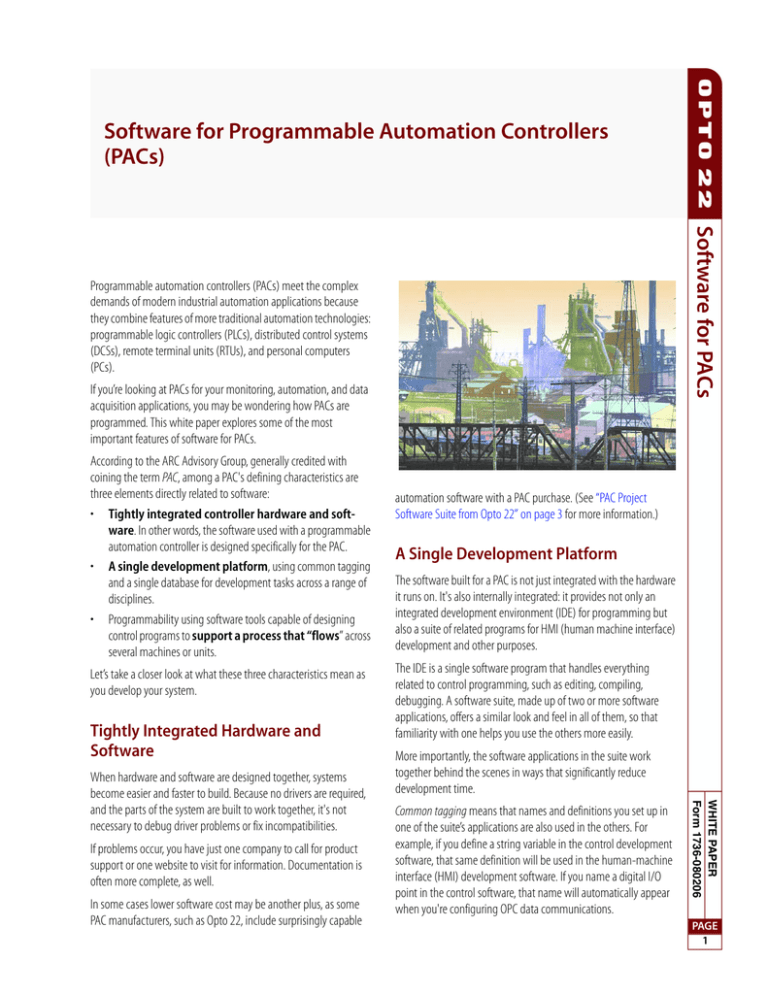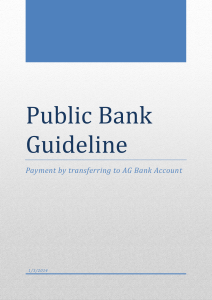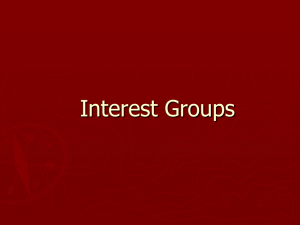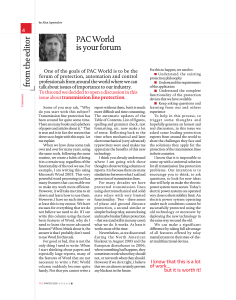
Software for Programmable Automation Controllers
(PACs)
Software for PACs
Programmable automation controllers (PACs) meet the complex
demands of modern industrial automation applications because
they combine features of more traditional automation technologies:
programmable logic controllers (PLCs), distributed control systems
(DCSs), remote terminal units (RTUs), and personal computers
(PCs).
If you’re looking at PACs for your monitoring, automation, and data
acquisition applications, you may be wondering how PACs are
programmed. This white paper explores some of the most
important features of software for PACs.
According to the ARC Advisory Group, generally credited with
coining the term PAC, among a PAC's defining characteristics are
three elements directly related to software:
• Tightly integrated controller hardware and software. In other words, the software used with a programmable
automation controller is designed specifically for the PAC.
• A single development platform, using common tagging
and a single database for development tasks across a range of
disciplines.
• Programmability using software tools capable of designing
control programs to support a process that “flows” across
several machines or units.
Let’s take a closer look at what these three characteristics mean as
you develop your system.
Tightly Integrated Hardware and
Software
If problems occur, you have just one company to call for product
support or one website to visit for information. Documentation is
often more complete, as well.
In some cases lower software cost may be another plus, as some
PAC manufacturers, such as Opto 22, include surprisingly capable
A Single Development Platform
The software built for a PAC is not just integrated with the hardware
it runs on. It's also internally integrated: it provides not only an
integrated development environment (IDE) for programming but
also a suite of related programs for HMI (human machine interface)
development and other purposes.
The IDE is a single software program that handles everything
related to control programming, such as editing, compiling,
debugging. A software suite, made up of two or more software
applications, offers a similar look and feel in all of them, so that
familiarity with one helps you use the others more easily.
More importantly, the software applications in the suite work
together behind the scenes in ways that significantly reduce
development time.
Common tagging means that names and definitions you set up in
one of the suite’s applications are also used in the others. For
example, if you define a string variable in the control development
software, that same definition will be used in the human-machine
interface (HMI) development software. If you name a digital I/O
point in the control software, that name will automatically appear
when you're configuring OPC data communications.
WHITE PAPER
Form 1736-080206
When hardware and software are designed together, systems
become easier and faster to build. Because no drivers are required,
and the parts of the system are built to work together, it's not
necessary to debug driver problems or fix incompatibilities.
automation software with a PAC purchase. (See “PAC Project
Software Suite from Opto 22” on page 3 for more information.)
PAGE
1
Software for Programmable Automation Controllers (PACs)
Because all these common tags you define are kept in a single
database that all the applications in the software suite use, you don't
have to reenter tags or maintain and reconcile lists of them. As a result,
development tasks can be finished more quickly and easily.
•
•
Supporting a Process that Flows
Because a key defining characteristic of PACs is that the same
hardware can be used in multiple domains, including logic, motion,
drives, and process control, it follows that the software must be
capable of programming all control and monitoring tasks that must be
done in multiple domains.
That means that the PAC software must handle discrete control,
process control, motion control, remote monitoring, and data
acquisition. And the software must let the developer mix and
incorporate these as needed into control programs, so these programs
can “flow” as the requirements of the application dictate.
Example: Microbrewery
For example, suppose your company is a microbrewery. Here are just
some of the requirements for producing your end product:
PAGE
2
•
•
•
•
Water is piped in from a spring a couple of miles away, so you
need to monitor the pressure and flow of that water as well
as security at the spring (remote monitoring using analog and
digital devices).
You measure water quality as it enters your facility, track this
data over time, and store it in your company database (data
acquisition, database connectivity).
You make more than one microbrew, so recipes, temperatures,
and processing must vary (batch process control, PID loop control, distributed control).
Operator interfaces mimic the process, providing secure
interactive controls for technicians and operators.
Quality control is essential to your reputation, so you test all products at several stages. Quality data is kept as required by
government health authorities (monitoring, more data acquisition
and database connectivity).
In another building, the bottling line requires discrete control.
As bottles come off the line, they are boxed and identified with
radio-frequency identification (RFID) tags, then sent on to shipping.
Software for Programmable Automation Controllers (PACs)
•
•
•
In the separate shipping area, boxed stock automatically moves
via conveyors (discrete control) based on RFID tags (serial
device connectivity).
Temperatures in the storage area are controlled and monitored.
Energy usage is monitored and building systems controlled
throughout all buildings (remote I/O, distributed intelligence).
Production and inventory data go directly from machines
and barcode readers to company computers; customer and shipping data flows in the opposite direction (database connectivity).
I/O points and variables you define while building a control program
(called a control strategy) are stored in a single tagname database.
When you open the HMI development, OPC server, or database
connectivity software, those defined items are immediately available
for use.
This microbrewery is just an example of how several different types of
control in several different domains, to use ARC's term, are required by
a modern industrial automation application.
Most industrial applications today are similarly varied. While the
number of PACs needed will depend on application requirements,
each PAC can be used in any domain or in multiple domains. Because
the application requires processes that flow into each other over space
and time, the PAC software accommodates that flow and integrates
these multiple domains into one system.
PAC Display HMI development software uses the same database of I/O
points and variables as PAC Control.
PAC Project Software Suite from Opto 22
Opto 22's PAC Project software suite is an example of PAC software.
Fully integrated with SNAP PAC controllers, the suite includes control
programming and HMI development software, plus optional OPC
server and database connectivity software.
Control programming incorporates multiple domains by including
commands for digital and analog control; PID loop control; logical and
mathematical operators; string handling; time/date and timers;
event/reactions; communication with distributed I/O, peers, and
computers on the network; testing and error handling. Motion control
commands are also available. All these commands are in plain English
and can be used in the control strategy you build, both in flowcharts
and in scripting blocks within a flowchart.
For more information about PAC Project software, visit the Opto 22
website, www.opto22.com.
Flowchart-based PAC Control development software from Opto 22 is fully
integrated with SNAP PAC programmable automation controllers.
PAGE
3
More About Opto 22
Products
SNAP PAC Brains
Opto 22 develops and manufactures reliable, flexible, easy-to-use
hardware and software products for industrial automation, remote
monitoring, and data acquisition applications.
SNAP PAC System
Designed to simplify the typically complex process of
understanding, selecting, buying, and applying an automation
system, the SNAP PAC System
consists of four integrated
components:
• SNAP PAC controllers
• PAC Project™ Software Suite
• SNAP PAC brains
• SNAP I/O™
While SNAP PAC controllers provide central control and data
distribution, SNAP PAC brains provide distributed intelligence for
I/O processing and communications. Brains offer analog, digital,
and serial functions, including thermocouple linearization; PID loop
control; and optional high-speed digital counting (up to 20 kHz),
quadrature counting, TPO, and pulse generation and measurement.
SNAP I/O
I/O provides the local connection to sensors and equipment.
Opto 22 SNAP I/O offers 1 to 32 points of reliable I/O per module,
depending on the type of module and your needs. Analog,
digital, serial, and special-purpose modules are all mixed on
the same mounting rack and controlled by the same processor
(SNAP PAC brain or rack-mounted controller).
Quality
SNAP PAC Controllers
Programmable automation controllers
(PACs) are multifunctional, multidomain,
modular controllers based on open standards and
providing an integrated development environment.
Opto 22 has been manufacturing PACs for many years. The latest
models include the standalone SNAP PAC S-series and the rackmounted SNAP PAC R-series. Both handle a wide range of digital,
analog, and serial functions and are equally suited to data
collection, remote monitoring, process control, and discrete and
hybrid manufacturing.
SNAP PACs are based on open Ethernet and Internet Protocol (IP)
standards, so you can build or extend a system without the expense
and limitations of proprietary networks and protocols.
PAC Project Software Suite
Opto 22’s PAC Project Software Suite provides full-featured and
cost-effective control programming, HMI (human machine
interface) development and runtime, OPC server, and database
connectivity software to power your SNAP PAC System.
These fully integrated software applications share a single tagname
database, so the data points you configure in PAC Control™ are
immediately available for use in PAC Display™, OptoOPCServer™,
and OptoDataLink™. Commands are in plain English; variables and
I/O point names are fully descriptive.
PAC Project Basic offers control and HMI tools and is free for
download on our website, www.opto22.com. PAC Project
Professional, available for separate purchase, adds OptoOPCServer,
OptoDataLink, options for Ethernet link redundancy or segmented
networking, and support for legacy Opto 22 serial mistic™ I/O units.
Founded in 1974 and with over 85 million devices sold,
Opto 22 has established a worldwide reputation for highquality products. All are made in the U.S.A. at our
manufacturing facility in Temecula, California. Because we
do no statistical testing and each part is tested twice before leaving
our factory, we can guarantee most solid-state relays and optically
isolated I/O modules for life.
Free Product Support
Opto 22’s Product Support Group offers free, comprehensive
technical support for Opto 22 products. Our staff of support
engineers represents decades of training and experience. Product
support is available in English and Spanish, by phone or email,
Monday through Friday, 7 a.m. to 5 p.m. PST.
Free Customer Training
Hands-on training classes for the SNAP PAC System are offered at
our headquarters in Temecula, California. Each student has his or
her own learning station; classes are limited to nine students.
Registration for the free training class is on a first-come, first-served
basis. See our website, www.opto22.com, for more information or
email training@opto22.com.
Purchasing Opto 22 Products
Opto 22 products are sold directly and through a worldwide
network of distributors, partners, and system integrators. For more
information, contact Opto 22 headquarters at 800-321-6786 or
951-695-3000, or visit our website at www.opto22.com.
www.opto22.com
www.opto22.com • Opto 22 • 43044 Business Park Drive • Temecula, CA 92590-3614 • Form 1335-070717
SALES 800-321-6786 • 951-695-3000 • FAX 951-695-3095 • sales@opto22.com • SUPPORT 800-835-6786 • 951-695-3080 • FAX 951-695-3017 • support@opto22.com
© 2007 Opto 22. All rights reserved. Dimensions and specifications are subject to change. Brand or product names used herein are trademarks or registered trademarks of their respective companies or organizations.



